WASHINGTON, D.C. -- French President Nicolas Sarkozy encouraged world leaders last month to take part in a "great revolution" in the way countries measure economic progress. Sarkozy urged leaders to move beyond traditional economic measures such as gross domestic product (GDP) in considering their societies' overall wellbeing. Gallup's global surveys underscore the extent to which life quality relates to a range of factors beyond classical economic measures. Survey results from up to 138 countries indicate that measures not directly related to market production, such as social connectedness and health satisfaction, strongly relate to how respondents rate their lives.
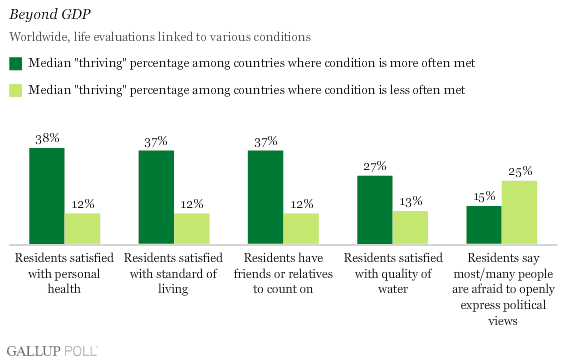
A report by the Commission on the Measurement of Economic Performance and Social Progress (PDF download) (CMEPSP), requested by Sarkozy in 2008, was released Sept. 14. Led by Nobel Prize laureates Joseph Stiglitz and Amartya Sen, the CMEPSP brought together noted economists and social scientists with a variety of specializations.
The authors call for the development of new quality-of-life measures that address eight dimensions thought to be associated with wellbeing worldwide. They emphasize the importance of objective and subjective measures, noting that data on people's "reported or experienced wellbeing" are needed to bridge the gaps created by "large discrepancies between standard assumptions of economic theory and real-world phenomena."
International surveys represent one important type of subjective measure. Gallup's ongoing poll of more than 150 countries and areas features questions relevant to each of the eight dimensions listed by the commission. Naturally these factors are interrelated, operating jointly to shape an individual's overall sense of wellbeing. However, even considered separately, responses to questions that address each dimension are linked to how positively respondents evaluate their lives overall.
Foundations of Wellbeing
The following graphs show aggregated results from surveys conducted in up to 138 countries and areas between 2006 and 2009. They demonstrate how questions relating to each of the eight dimensions in the CMEPSP report are associated with residents' overall life evaluations. Such evaluations represent one aspect of wellbeing measurement, though it is also important to consider people's more immediate emotional states. Gallup's Life Evaluation Scale, based on the Cantril Self-Anchoring Scale, classifies respondents as "thriving," "struggling," or "suffering" according to how they rate the overall quality of their current and future lives.
For each one of the eight graphs, countries are divided into two groups: 1) those above the worldwide median on the question being considered (for example, countries where residents are more likely to be satisfied with their standard of living), and 2) those below the worldwide median (where residents are less likely to be satisfied with their standard of living).
Then, life evaluation ratings are compared between the two country groups (reported as the median thriving, struggling, and suffering percentages among each group) to give an idea how differently people view their lives in countries where each condition is met versus those where it is not. The countries' thriving percentages are significantly related to seven of the eight CMEPSP dimensions, even when the countries' average income (per-capita GDP) levels are factored out (the only exception is the final question).
-
Material living standards: This is the area most closely related to the "traditional" concept of economic wellbeing -- how much people can buy or do. Among countries where respondents are more likely to be satisfied with their living standards, the median proportion of thriving residents is 37%; among countries where respondents are less likely to be satisfied with their living standards the median thriving proportion is 12% of residents. The considerable gap between the groups supports the notion that behavioral economic measures beyond income can broaden the definition of a population's true economic health. Thriving gap: 25 percentage points
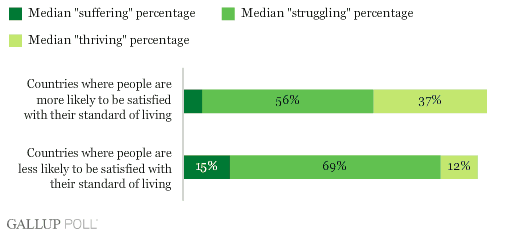
-
Health: In the developed world, health statistics are routinely reported and used to make policy decisions. However, as the CMEPSP report notes, even basic health statistics such as mortality rates are notoriously sparse and unreliable in much of the developing world. Global Gallup data measure how satisfied people are with their personal health and reveal that among countries where people are more likely to be satisfied, the median thriving percentage is about three times as high as the median among countries where people are less likely to be satisfied with their personal health. Thriving gap: 26 points
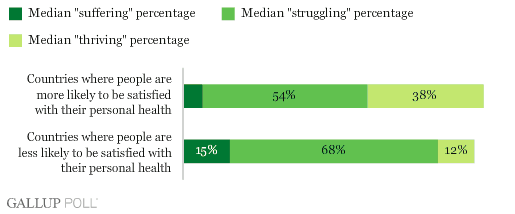
-
Education: While education is clearly important to individuals' employment prospects, the CMEPSP report argues that it also "matters for quality of life independently of its effects on people's earnings and productivity." Among countries whose populations are above the median in terms of average educational attainment, the median thriving proportion is 35%, much higher than the 15% among countries with lower average education levels. Thriving gap: 20 points
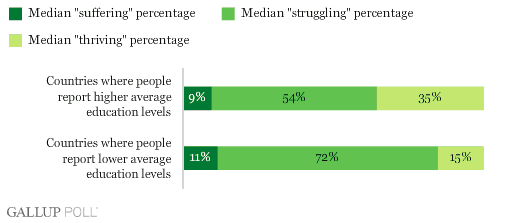
-
Personal activities: The CMEPSP report cites previous research showing that the activities people engage in on a daily basis matter greatly to their quality of life. The availability and quality of work is a major consideration in this area. However, simply engaging in some type of fulfilling activity may make some difference: Among countries where people are more likely to say they had learned or done something interesting the previous day, the median thriving percentage (25%) was somewhat higher than the median percentage among countries where people are less likely to have learned or done something interesting (19%). Thriving gap: 6 points
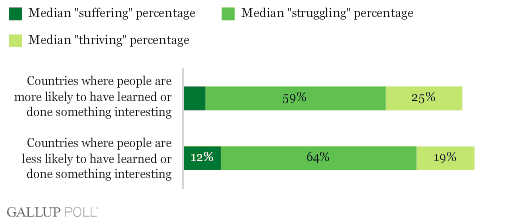
-
Political voice and governance: The World Bank has joined non-governmental organizations such as Freedom House and Transparency International in releasing governance ratings that identify regimes that suppress political dissent and lack accountability to their constituents. Measures such as GDP fail to account for negative effects of authoritarian governance on wellbeing, particularly when it results in restricted freedoms or the preservation of huge inequalities within a country. Among countries where people are more likely to say most or many people are afraid to openly express their political views, the median thriving proportion is 15%, versus 25% among countries where such fear is not so commonly perceived. Thriving gap: 10 points
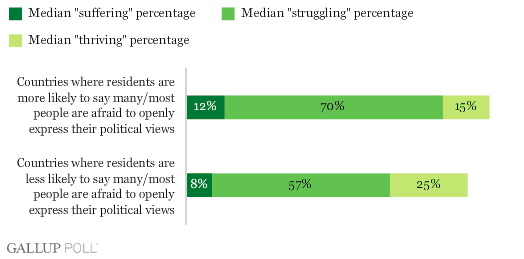
-
Social connections and relationships: Over the past 20 years, researchers such as Harvard's Robert Putman -- a CMEPSP member -- have made the case that social networks, social trust, and other forms of "social capital" are important to political and economic outcomes, as well as to personal wellbeing. A previous analysis of Gallup-Healthways Well-Being Index data revealed the degree to which Americans' daily happiness and stress levels are strongly related to the amount of time they spend with friends and family. In this current analysis, the median thriving percentage among countries where people are more likely to say they have friends or relatives to count on in times of trouble is about three times the median percentage among countries whose residents are less likely to have people they can count on (37% vs. 12%, respectively). Thriving gap: 25 points
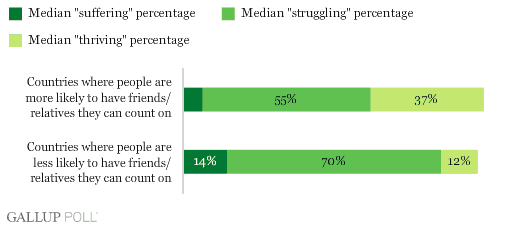
-
Environmental conditions: Population growth and climate change are exacerbating environmental problems that dramatically affect living conditions in much of the developing world. Lack of access to safe, clean water in particular is a problem that threatens millions and has led some to call for recognition of water access as a basic human right. The median thriving proportion among countries where people are more likely to be satisfied with the quality of water in their areas is 27%, versus 13% among countries where people are less likely to be satisfied with water quality. Thriving gap: 14 points
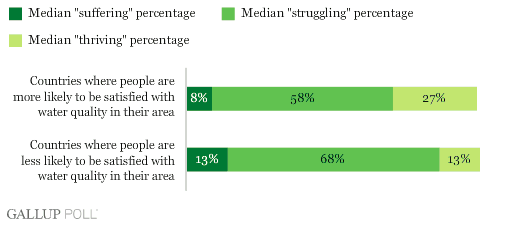
-
Economic and physical insecurity: Finally, the CMEPSP report discusses the negative consequences of economic and physical insecurity for the quality of life. The effects of economic insecurity are clear: Countries where more people say their standard of living is improving have higher thriving percentages than those where more people say their standard of living is staying the same or declining. With regard to safety from physical threats such as crime, however, the global data are much less conclusive: Among countries where people are more likely to feel safe walking alone in their neighborhoods at night, the median thriving proportion is 23%, similar to the 20% among countries where people are less likely to feel safe. Thriving gap: 3 points
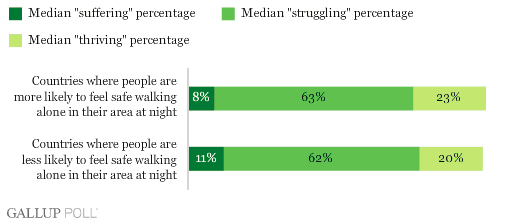
Bottom Line
The call for a more comprehensive and nuanced approach to measuring a population's economic status has the potential to redirect development resources in ways that more reliably improve the wellbeing of individuals and communities around the world. Gallup data reflect the importance of studying a range of wellbeing indicators to better understand how they interrelate and are influenced by cultural, regional, or community-based conditions. Such an understanding may expand the array of strategies for leaders and development experts to consider as they work to provide more the world's citizens with the tools they need to live happy, productive lives -- and in turn to boost the wellbeing, as well as the productivity, of their societies.
For complete data sets or custom research from the more than 150 countries Gallup continually surveys, please contact worldpollpartners@gallup.com or call 202.715.3030.
Survey Methods
Results are based on telephone and face-to-face interviews with more than 137,000 adults, aged 15 and older, conducted between 2005 and 2009 in 139 countries. For results based on the total samples of national adults in each country, one can say with 95% confidence that the maximum margin of sampling error ranged from a low of ±2.2 percentage points in Russia to a high of ±4.4 percentage points in Trinidad and Tobago. In addition to sampling error, question wording and practical difficulties in conducting surveys can introduce error or bias into the findings of public opinion polls.








